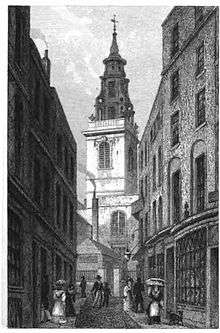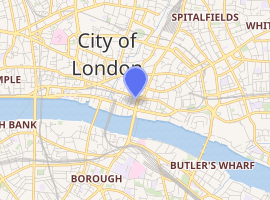St Michael, Crooked Lane
St Michael, Crooked Lane was an ancient parish church situated on the east side of Miles's Lane[1] in Candlewick Ward in the City of London.[2] It was rebuilt after the Great Fire of London by Sir Christopher Wren, and demolished in 1831.
| St. Michael, Crooked Lane | |
|---|---|
 | |

| |
| Location | Miles' Lane, London |
| Country | United Kingdom |
| Denomination | Church of England |
| Architecture | |
| Architect(s) | Christopher Wren |
| Style | Baroque |
| Demolished | 1831 |
History
The church was in existence by 1304. It was an originally a small church, standing amongst the slaughter-yards of the butchers of Eastcheap. In 1336, it was rebuilt on a much larger scale by John Lovekeyn, four-times Lord Mayor of London; later it received further benefactions from Sir William Walworth, who was Lord Mayor in 1374.[1] The patronage of the church belonged first to the prior and convent of Christ Church, Canterbury until 1408, and later to the Archbishop of Canterbury, becoming one of 13 peculiarities in the City of London belonging to him.[1][3]
It was in the parish that the first cases of The Plague occurred in 1665.[4]
After its destruction in the Great Fire of London, the church was rebuilt by Sir Christopher Wren in 1687. The interior of the new church was 78 feet long, 46 feet wide and 32 feet high, with round-headed windows.[1] James Peller Malcolm called Wren’s church "so plain as to be indescribable", noting only the Corinthian reredos, "the usual tablets" and the lack of an organ.[3] There was a Portland stone tower, about 100 feet high, topped with a perforated parapet, with vases at its angles, and a spire—described by James Elmes as "remarkably picturesque"—with clock, weather-vane and cross.[1]
In 1789, Thomas Townsend left a house and funds to the Merchant Taylors Company to endow a weekly lecture and a clerical post at the church. His widow Susannah (d. 1810) left further funds to support this work. In 1831, the bequest was transferred to the church of St Magnus, London Bridge. [5]
The church was demolished in 1831[6] to make way for the wider approaches needed for the rebuilt London Bridge.[7] Its parish was united with that of St Magnus the Martyr. A stained-glass window in the church of St Magnus commemorates the former parish.
Some of the monuments in the demolished church are now located in St Mark's Church, Kennington.[8]
Washington Irving gave a long description of the church in his famed work The Sketch Book (published originally in 1863, republished by Avenal Books/Crown Publishers in 1985), in the chapter entitled "The Boar's Head Tavern, Eastcheap". In searching for any remnants of Shakespeare's Falstaff, Irving hears about a picture of the original tavern in St. Michael's church, but to no avail. Still, as always with author Irving, the trip is an entertaining and amusing one.
See also
- List of Christopher Wren churches in London
- List of churches rebuilt after the Great Fire but since demolished
References
- Elmes, James (1831). A Topographical Dictionary of London and its Environs. London: Whittaker, Treacher and Arnot. p. 303. Retrieved 24 September 2011.
- Candlewick Ward History
- Malcolm, James Peller (1807). Londinium Redivivium, or, an Ancient History and Modern Description of London. 4. London. pp. 506–8.
- Samuel Pepys's Diary: April 30, 1665 (Dover, Lewis Publications 1992) ISBN 978-0-486-43667-8
- Clode, C M. "Memorial CXVII: Townsend's Lectureship Pages 363-364 Memorials of the Guild of Merchant Taylors of the Fraternity of St. John the Baptist in the City of London. Originally published by Harrison, London, 1875". British History Online. Retrieved 16 August 2020.
- "The London Encyclopaedia" Hibbert, C; Weinreb, D; Keay,J: London, Pan Macmillan, 1983 (rev 1993,2008) ISBN 978-1-4050-4924-5
- The Church Of St. Michael, Crooked Lane Correspondent not cited The Times, Thursday, Apr 07, 1831; pg. 3; Issue 14507; col F
- "Monuments of St Mark's Kennington". www.speel.me.uk. Retrieved 2020-07-18.